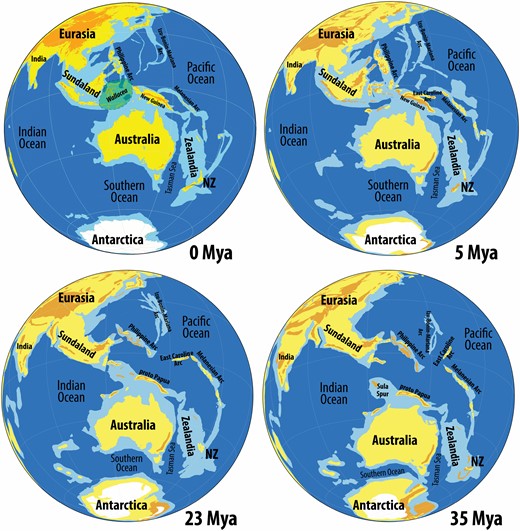-
Welcome to BirdForum, the internet's largest birding community with thousands of members from all over the world. The forums are dedicated to wild birds, birding, binoculars and equipment and all that goes with it.
Please register for an account to take part in the discussions in the forum, post your pictures in the gallery and more.
You are using an out of date browser. It may not display this or other websites correctly.
You should upgrade or use an alternative browser.
You should upgrade or use an alternative browser.
My taxonomic predictions (1 Viewer)
- Thread starter Jim LeNomenclatoriste
- Start date
More options
Who Replied?Mysticete
Well-known member

My classification for Caprimulgiformes. I am a bit more radical with this group than most, recognizing 4 subfamilies, and 4 tribes within Caprimulginae. Unfortunately, and I am sure someone will correct me if I am wrong, there are not formerly named family/subfamily/tribes for several of these clades, which I have put in " ".
Caprimulgiformes
Caprimulgidae
Eurostopodinae
Eurostopodus
"Lyncorninae"
Lyncornis
"Gactorninae"
Gactornis
Caprimulginae
Nyctidromini
Nyctiprogne, Lurocalis, Nyctipolus, Nyctidromus, Tepuiornis, Uropsalis, Quechuavis, Setopagis, Eleothreptus, Systellura, Hydropsalis
"Antrostomini"
Siphonorhis, Nyctiphrynus, Phalaenoptilus, Antrostomus
Chordeilini
Podager, Chordeiles
Caprimulgini
Veles, Caprimulgus
Caprimulgiformes
Caprimulgidae
Eurostopodinae
Eurostopodus
"Lyncorninae"
Lyncornis
"Gactorninae"
Gactornis
Caprimulginae
Nyctidromini
Nyctiprogne, Lurocalis, Nyctipolus, Nyctidromus, Tepuiornis, Uropsalis, Quechuavis, Setopagis, Eleothreptus, Systellura, Hydropsalis
"Antrostomini"
Siphonorhis, Nyctiphrynus, Phalaenoptilus, Antrostomus
Chordeilini
Podager, Chordeiles
Caprimulgini
Veles, Caprimulgus
l_raty
laurent raty
Unfortunately, and I am sure someone will correct me if I am wrong, there are not formerly named family/subfamily/tribes for several of these clades, which I have put in " ".
Pretty sure no family-group name was proposed for the recent Gactornis, and I have no trace of a name based on Lyncornis either. I would make these name Gactornithinae and Lyncornithinae, though, as they end in a transliteration of ὄρνις, -ιθος, a bird in Greek.
I would attribute Antrostomini (which I had overlooked so far, too -- despite having checked this journal for family-group names previously) to Shufeldt 1889.
Last edited:
Acanthis
Well-known member
That's a pity.I'd be a bit cautious about it.
First, this is based only on a cyt-b sequence -- this is the only gene that has been sequenced for Columba larvata.
Second, there are five cyt-b sequences for this species in GenBank (4 from Valente et al 2020, and a shorter one from Wilson et al 2022). Four of these are very similar to one another, while the fifth one is rather (~5%) divergent (and has quite a few unidentified nucleotides) -- this sequence might conceivably be problematic. Unfortunately, this divergent sequence is also the longest of the five, and is the one that Oliver et al 2023 chose to use in their supermatrix.
The possibility of a relationship between the three Columba (subgenus Turturoena) species and the more terrestrial larvata was intriguing.
Acanthis
Well-known member
My list is very similar, the main difference being the restriction of Raphinae to the diverse collection of unique old oddball lineages, and the consequent raising of Treroni- and Ptilinopi- to subfamily level. I haven't decided what to do with Phapitreroni- yet.I finally am nearing completion of Columbiformes for my checklist. Ultimately, I stuck to subfamilies for now rather than elevating some to family status. This is mostly because I observed enough variation in molecular clock data that I am not convinced we have a firm grasp of how far back some of them diverged. Hell I am not sure we actually know for certain what is going on with the Australasian species on the basic relationship level
My listing isn't particularly controversial...I think folks have been pretty good at fixing the most glaring issues. If you have comments or thoughts or things you think should be subdivided more/differently, let me know! FYI green text is not yet accepted by IOC and red text is extinct
Columbidae
Claravinae
Claravis, Uropelia, Paraclavis, Metropelia, Columbina
Columbinae
Zenaidini
Geotrygon, Leptotrygon, Leptoptila, Zentrygon, Zenaida
Columbini
Ectopistes, Reinwardtoena, Turacoena, Macropygia, Patagioenas, Streptopelia, Nesoenas, Spilopelia, Columba
Starnoenadinae
Starnoenas
Phabinae
Diopezus, "Gallicolumba" rufigula, Gallicolumba, Geopelia, Henicophaps, Ocyphaps, Leucosarcia, Petrophassa, Geophaps, Phaps, Pampusana
Raphinae
Treronini
Treron
Chalcophabini
Chalcophaps, Oena, Turtur
Otidiphabinae
Microgoura, Trugon, Otidiphaps
Raphini
Pezophaps, Raphus, Caloenas, Bountyphaps
Gourini
Didunculus, Goura, Natunaornis
Phapitreronini
Phapitreron
Ptilinopini
Hemiphaga, Gymnophaps, Lopholaimus, Cryptophaps, Ducula, Tongoenas, Megaloprepia, Ramphiculus, Alectroenas, Drepanoptila, Chrysoena, Ptilinopus
Acanthis
Well-known member
If the Ptilinopinae part the tree (Fig. S4) in this paper is accurate then the relationship between Chrysoena and Ptilinopus melanospilus suggests using Haemataena for melanospilus might be a better option.
Oligo-Miocene radiation within South-west Pacific arc terranes underpinned repeated upstream continental dispersals in pigeons (Columbiformes)
Abstract. Upstream colonizations from islands to continents have played an important role in two major global bird radiations: the oscine passerines and thacademic.oup.com
Also Ptilinopus nainus appears to be closer to Drepanoptila holosericea than other members of its genus. It seems a bit distant to be easily included in Drepanoptila and I don't know if another genus name is available.
Mysticete
Well-known member

Chrysoena?Also Ptilinopus nainus appears to be closer to Drepanoptila holosericea than other members of its genus. It seems a bit distant to be easily included in Drepanoptila and I don't know if another genus name is available.
Acanthis
Well-known member
This seems to apply just to three Fijian endemics though another paper ( https://www.sciencedirect.com/science/article/abs/pii/S1055790313003412 ) does place Drepanoptila and nainus close to Chrysoena, whereas in this one they are closer to Alectroenas. They're all pretty distinct anyway.Chrysoena?
Last edited:
Users who are viewing this thread
Total: 2 (members: 0, guests: 2)



